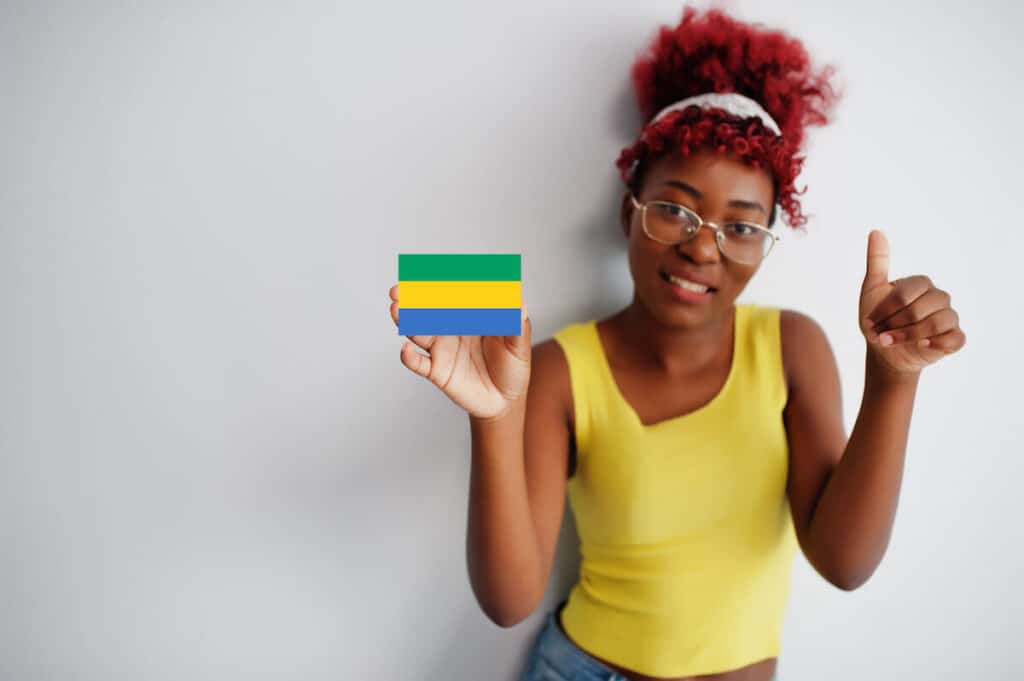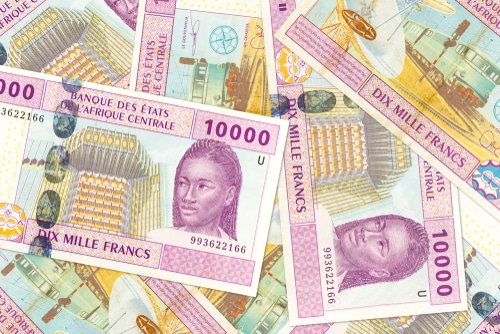Whether you are a one-time traveler, a regular visitor, or have friends and family in Gabon, there’s much to learn about the country and its fascinating history. So, our team here at Remitly gathered six interesting facts about Gabon’s currency and everything else you need to know before visiting.
Officially known as the Gabonese Republic, Gabon is a small, sparsely populated country on the west coast of Central Africa. The equator passes through the country, and Cameroon, the Republic of the Congo, Equatorial Guinea, and the Atlantic Ocean surround it.
The official Gabon currency is the Central African CFA franc, denoted by the currency code XAF. Rainforests cover nearly 90% of Gabon, and the country houses 80% of Africa’s gorilla population, making it an excellent destination for nature lovers.
What is the Gabon currency?
As mentioned, the Central African CFA franc is Gabon’s official currency. Five other African countries also share the Gabon currency:
- Cameroon
- Central African Republic
- Chad
- Republic of the Congo
- Equatorial Guinea
The “CFA” in the name Central African CFA franc stands for “Coopération financière en Afrique centrale,” which translates to “Financial Cooperation in Central Africa.” The Bank of Central African States (BEAC) issues the Gabon currency.
History of the Gabon currency: Central African CFA franc (XAF)
Gabon is a former French colony, significantly influencing how Gabon currency works today and how the Central African CFA franc (XAF) evolved over the years.
In 1910, the French colonized some African countries, naming the region French Equatorial Africa. These French colonies included:
- Chad
- Gabon
- Middle Congo (now the Republic of the Congo)
- Ubangi-Shari (now the Central African Republic)
The colonized regions shared a common currency known as the French franc. In 1945, the CFA franc replaced the French franc due to an agreement signed between the French treasury and the International Monetary Fund. During this time, the CFA franc stood for “franc of the French Colonies of Africa.”
Gabon remained under French control until it gained independence in 1960. After the remaining territories gained independence, the countries (including Gabon) continued using the CFA franc, but they now call it the Central African CFA franc. CFA is now the “franc of Financial of Cooperation in Central Africa.”
A group of West African countries also use a CFA franc called the West African CFA franc. In that currency, CFA stands for “franc of the African Financial Community” or “Communauté Financière Africaine” in French.
Historical and current denominations of Gabon currency
In 1943, France introduced the first coins in Gabon in denominations of 5, 10, 25, and 50 centimes, as well as a 1-franc coin. While banknotes were already circulating in the French colonies of Africa (French Equatorial Africa), in 1947, a series of new notes were issued. These were in denominations of 5, 10, 20, 50, 100, and 1,000 francs.
Today, the Bank of Central African States (BEAC) manages and issues the country’s currency. The following coin and banknote denominations are available.
Coins of Gabon’s currency:
- 1 franc
- 2 francs
- 5 francs
- 10 francs
- 25 francs
- 50 francs
- 100 francs
- 500 francs
Banknotes of Gabon currency:
- 500 francs
- 1,000 francs
- 2,000 francs
- 5,000 francs
- 10,000 francs
One franc is divided into 100 smaller units called centime. However, no centime denominations are actually issued in Gabon.
6 Interesting facts about Gabon’s currency

1. The currency shares the name “franc” with several other currencies.
The Central African CFA franc isn’t the only currency with the name “franc.” It’s used for many other foreign currencies, including the Swiss franc, the West African CFA franc, the Guinean franc, and more.
Countries like France and Belgium also used the franc in the past but have now switched to the euro.
2. Gabon’s currency is similar to the West African CFA franc.
Gabon’s currency, the Central African CFA franc (XAF) and the West African CFA franc (XOF), not only sound similar but also share the same monetary value. You still have to convert the currency for use in different regions, but the exchange rate is one-to-one, meaning 1 XAF equals 1 XOF.
As the name suggests, the major difference between the currencies is that different member states in the African financial community use each type of CFA franc. Eight independent states in West Africa use the West African CFA franc. These include:
- Benin
- Burkina Faso
- Côte D’Ivoire
- Guinea-Bissau
- Mali
- Niger
- Senegal
- Togo
On the other hand, as mentioned above, a different currency called the Central African CFA franc (XAF) is used in six countries in Central Africa. These six independent states include:
- Cameroon
- Central African Republic
- Chad
- Equatorial Guinea (the only former Spanish colony to use the XAF)
- Gabon
- Republic of the Congo
Another difference is the currency code. XAF denotes the Central African CFA franc, while XOF denotes the West African CFA franc.
3. Only the Bank of Central African States (BEAC) can manage and issue the currency.
Only the central bank, the Bank of Central African States (BEAC), can issue and manage Gabon’s currency. The Bank of Central African States is headquartered in Cameroon and has been operational since its establishment in 1972.
4. The Central African CFA franc has a fixed exchange rate linked to the euro.
As the Central African CFA franc has the same monetary value as the West African CFA franc, both currencies have a fixed exchange rate pegged to the euro (EUR). This means the Gabon currency’s exchange rate with the euro remains at a fixed ratio as the euro’s value goes up or down.
5. You should carry cash when visiting Gabon.
The Central African CFA franc shares one more similarity with the West African CFA franc. Both are cash-heavy economies, so you must use local banknotes and coins when dealing with vendors.
Major businesses do accept credit cards and digital payments, but this can be limited to tourist areas and city centers, so it’s advisable to carry cash for local payments.
It is possible to send funds to friends and family in Gabon safely. To send or receive money online, you can use Remitly to make the transfers easier.
6. Eco, a new currency, may replace the CFA franc.
A new currency called Eco is a planned shared currency that would replace the West African CFA franc in countries that are a part of the West African Monetary Union.
There is now a debate among the economic and monetary community about whether the Central African countries should also replace their CFA franc.
What are the Gabon currency exchange rates?
The Gabon currency exchange rate is fixed and remains the same as the West African CFA franc, so 1 XAF = 1 XOF. The Central African CFA franc is pegged to the euro, but the exchange rate may vary with the U.S. dollar (USD), United Kingdom pound sterling (GBP), and other currencies around the world.
So, to find out how much is 1 USD to a CFA franc, you first look up the exchange rate. You see that 1 USD = 608.58 XAF.
Next, you’ll multiply the amount you want to convert by 608.58. For $100, that would work out to:
100 x 608.59 = 60,859 XAF
You can check the current foreign currency exchange rates with the currency converter on our website.
Sending money to Gabon
Any time you’re sending money to Gabon, Remitly can help. Remitly makes international money transfers faster, easier, more transparent, and more affordable. Our reliable and easy-to-use mobile app is trusted by over 5 million people around the world.
FAQs
Have lingering questions about the currency of Gabon? Read on for answers.
What is the currency of Gabon?
The currency of Gabon is the XAF or Central African franc. It is also the currency of Cameroon, the Central African Republic, Chad, the Republic of the Congo, and Equatorial Guinea.
How is the XAF franc different than the CFA franc?
The CFA is the currency of countries that form the West African Economic and Monetary Union. These nations are Benin, Burkina Faso, Côte D’Ivoire, Guinea-Bissau, Mali, Niger, Senegal, and Togo.
On the other hand, the XAF coins and banknotes are the official money in countries within the Economic and Monetary Community of Central African States, Cameroon, the Central African Republic, Chad, Gabon, the Republic of the Congo, and Equatorial Guinea.
Can I use euros in Gabon?
Some businesses in Gabon do accept euro coins and banknotes, but not all will. As a result, it is best to check ahead of time before trying to purchase with foreign currency.
Does Gabon use the French franc?
Gabon’s money is called the Central African franc, but it is not the same form of money that the French treasury once issued to serve as the national monetary unit in France. It is a unique monetary system administered by the central bank of the Central African states.
Can I use USD in Gabon?
Some businesses do accept US dollars in Gabon, but the bills and coins are not universally accepted. Inquire before attempting to use USD to pay for things like food, lodging, health care, and services.
What is the monetary unit of Gabon?
Central African francs are the monetary unit of Gabon.
